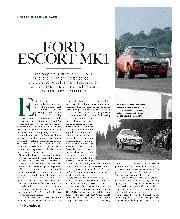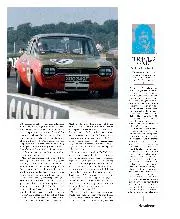Everything was in place. The pressure was on.
“It was a major stepping-stone,” says Mason. “I was very conscious of that and didn’t treat it lightly. But our close friendship eliminated worries of any sort.
“I knew Roger from competing against him and Jim on British events. We had hit it off – i.e. we liked a pint now and again – and I became a family friend.
“He didn’t tolerate fools and was selective in his friendships. But we had a similar sense of humour. A rapport, I suppose.
“If you are in a car together for a week you have to get on. Jim was quite reticent and couldn’t be more different from me. And yet. Stuart Turner was very astute.
“Our rally went like clockwork. Though not to plan: we hadn’t planned to be leading so soon.”
Clark grabbed the lead on the notoriously fickle spectator stages on the opening day and – bar a burst of speed by Fiat’s Håkan Lindberg in north Wales – held the lead thereafter.
The other three works Escorts were out before halfway and only Saab’s Stig Blomqvist, the winner in 1971, could hold a candle to the runaway Brit.
“You could feel Roger’s skill,” says Mason. “Sometimes during a stage I would look at his face and see how controlled he was. That was his home. He enjoyed being behind the wheel.
“He never acknowledged that he knew any of the forestry. Even if we had gone past his back garden I don’t think he would have recognised it or talked about it.
“I was very aware of driving Britain’s best rally driver but Roger just nodded off”
“Now and again I would give an exclamation if I had a note in my roadbook: a severe bend or well-known crashing point. But he didn’t need it. You just felt he was a machine.
“But I did do 70% of the road driving.
“Stuart had sent me to Jim Russell’s racing driver school at Mallory Park. I went every Saturday morning for about two months having stayed overnight at Roger’s. I got this certificate saying that I was premium grade, top class, or whatever. Roger thought that was very funny.
“But it helps being able to see things from both seats. I know what drivers want. And what they don’t want is a clever arse trying to show how good he is. I was very aware of driving Britain’s best rally driver – but Roger just nodded off. You couldn’t stop him. He’d wait until a stage start before swapping seats again.
“We knew we were leading and that the whole country was with us but it didn’t go to Roger’s head. He just tuned his mind to that marshal’s flag, and off we went. And that was it.
“Immediately after a stage I’d be checking my times and fiddling about, and there he’d be, stood waiting to get back into the passenger seat. He enjoyed the relaxation.”
Clark was happy to hand over to Mason after the intense stages
A half-spin at Donington Park and a fuelling issue in Yorkshire cured by plumbing the spare pump to run in parallel were their only problems until a junction arrow went AWOL with just nine stages to go.
“Suddenly I was completely lost,” says Mason. “The maps of the forests of western Scotland are not well defined.








